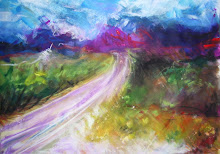
I've just finished the book "I Was Vermeer" by Frank Wynne. It is a true story about artist Han van Meegeren, one of the most famous forgers of the twentieth century. His fake Vermeer "Supper at Emmaus" was a Dutch national treasure and the most visited painting in the Netherlands. In fact, when Han was arrested and confessed many still refused to believe this was a forgery as it was simply so good. In order to prove he had the skill to produce such a genuine-looking Vermeer, the courts had him paint "a new Vermeer" watched by guards.

It was interesting to read about the fascinating subject of art forgery. Firstly I hadn't realised how widespread forgery of the masters is. Over the years many paintings have been "improved upon" or doctored as fashions change. Bits are cut out (often Joseph from the Holy family to create a more saleable Madonna & child), or bits repainted.
Michelangelo's fresco on the Sistine Chapel alter "The Last Judgement", shown right, was painted with the figures naked. Pope Paul III's advisor was shocked by the "shameless display of flesh" and an artist was commissioned after Michelangelo's death to add bits of cloth to cover up the figures.Secondly it takes an awful lot of skill and talent to forge Vermeer-type works of art. Firstly the forger must be intimately familiar and competent with the style of the artist they are attempting to copy. Many forgers are themselves failed or unrecognised artists. Van Meerger was himself a very skillful painter in the style of the old Dutch masters like Rembrandt. Unfortunately for him he was born about 300 years too late. He was painting just as modern art - Dali, Picasso, Mondrian - were transforming the art world. Nobody was interested in Han's old fashioned style.
In addition to artistic skill the forger must have an excellent practical knowledge of the canvas and paints which would have been used. Han bought genuine old canvases which he painted over. He couldn't use the new paints which were now available in tubes but had to mix them from the raw materials like lead or lapis lazuli, as Vermeer would have done. There is also the problem of giving the aged appearance. The craquelure is almost impossible to artificially produce. Simply baking a painting would produce cracks too uniform and would distort the paints and canvas. Han experimented with this for years and eventually built his own oven, using a complicated system of varnishing and baking the paintings.







No comments:
Post a Comment